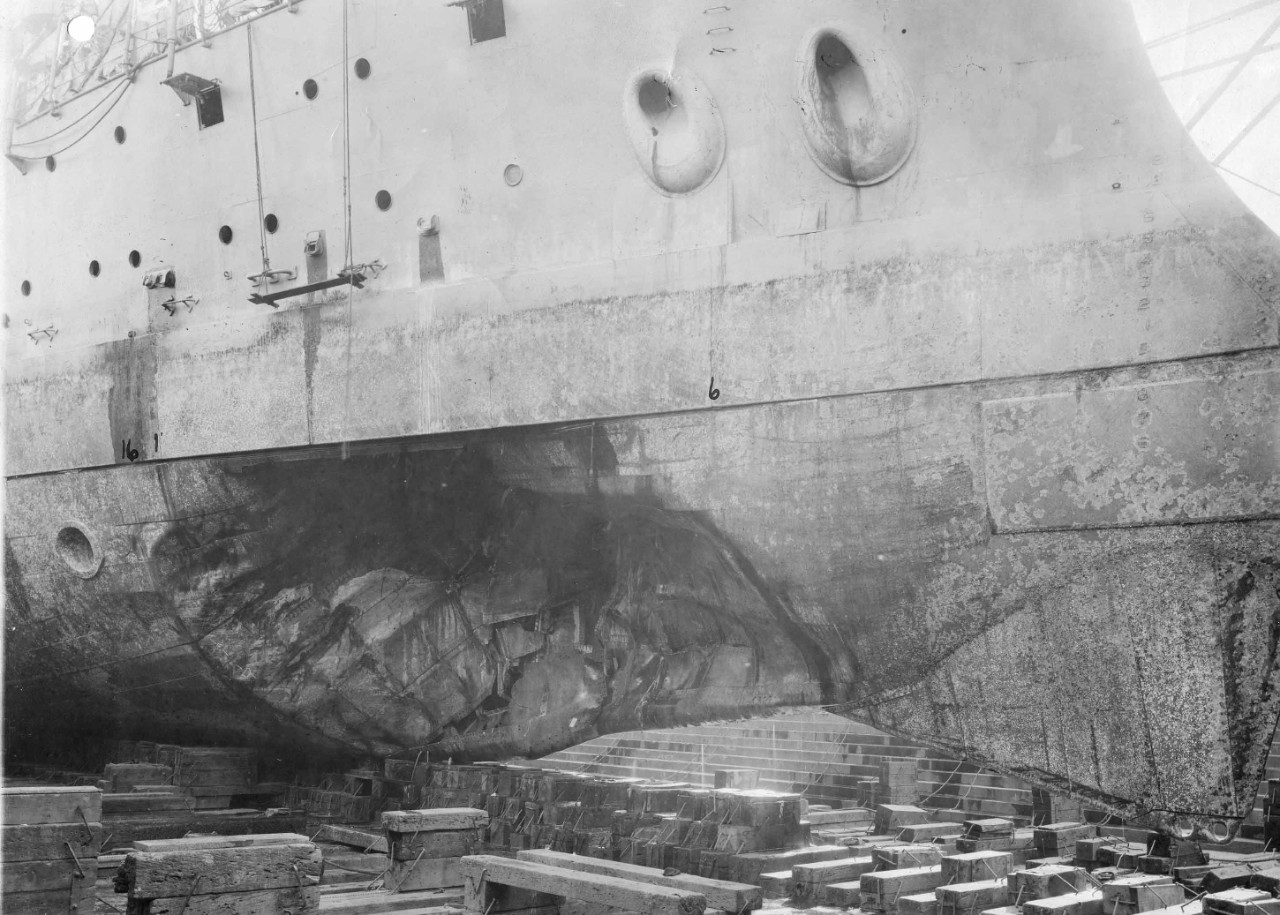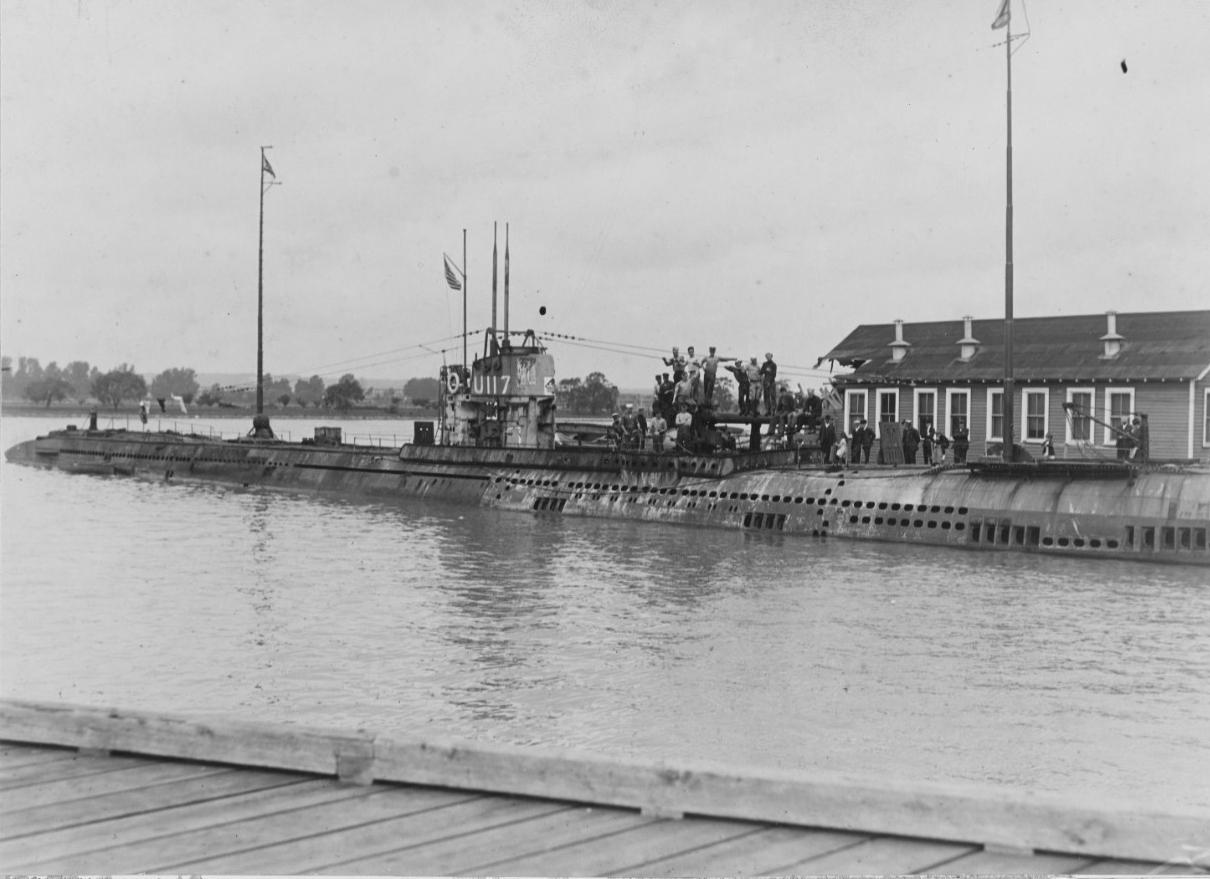U-117 (World War I Prize Submarine)
1919–1921
The Navy retained the alphanumeric name carried by this former Imperial German Navy vessel at the time of her acquisition.
(World War I Prize Submarine: displacement 1,164 (surfaced), 1,512 (submerged); 1ength 267½'; beam 24½'; draft 13¾'; speed 14.7 knots (surfaced), 7 knots (submerged); complement 40; armament 1 5.9-inch, 1 3.4-inch; 2 mine tubes, 42 mines, 4 20-inch torpedo tubes; class U-117)
U-117, a UE-II series long-range minelayer submarine, was laid down in 1917 at Hamburg, Germany, by Aktiengesellschaft Vulcan; launched on 10 December 1917; and commissioned in the Imperial German Navy on 28 March 1918, Kapitänleutnant Otto Dröscher in command.
After shakedown, U-117 was posted to the U-Kreuzer Verband (Submarine Cruiser Unit) on 1 June 1918. Over the next five weeks, she completed fitting out at Kiel. On 11 July, U-117 departed Kiel and took the eastern route through the Baltic around Denmark and out into the North Sea by way of the Skaggerak. After rounding the Shetland Islands, she set a course for the coast of North America to lay minefields off the coast of the United States and to conduct cruiser warfare. During the passage across the Atlantic, heavy weather foiled her attempts to attack two lone steamers, two convoys, and a small cruiser.
U-117 reached the U.S. coastal zone on 8 August 1918, and her fortunes improved soon thereafter. On 10 August, she encountered a fleet of fishing craft and went on a spree, sinking eight of the vessels with explosives and gunfire: Aleda May, Cruiser, Earl & Nettie, Katie L. Palmer, Mary E. Sennett, Progress, Reliance, and William H. Starbuck. On the 12th, she sighted the 3,875-ton steamer Sommerstadt, bound for New York in ballast, and, after observing that the Norwegian steamer was armed, made a submerged attack that sank her with a single torpedo. The following day [13 August], the U-boat made another submerged torpedo attack and hit the 7,127-ton U.S. tanker Frederic R. Kellogg bound from Tampico, Mexico, to Boston, Mass., with 7,500 barrels of crude oil. The ship sank within 15 seconds; seven men died. The action occurred only 12 miles north of Barnegat Light, however, in shallow water that enabled the ship to be salvaged by the end of the month.
Later that same day [13 August 1918], the minelayer submarine began the other half of her duty by laying mines near Barnegat Light. That field later claimed a victim when the 2,458-ton Mallory Line steamship San Saba, en route from New York to Mobile, struck a mine and sank on 4 October 1918, breaking in half and going down immediately; 30 men lost their lives. That same field may also have been responsible for the sinking of the 1,510-ton Cuban-flag freighter Chaparra, which had been en route from Havana to New York with a cargo of sugar on 27 October 1918.
U-117 paused in her mining operations on 14 August 1918, and resumed cruiser warfare when she encountered the 2,008-ton U.S. schooner Dorothy B. Barrett, en route from New York to Norfolk, Virginia. The U-boat brought her deck guns to bear on the sailing vessel and sent her to the bottom along with her cargo of coal. Shortly thereafter, however, the hunter became the hunted when an American seaplane forced the submarine to seek refuge beneath the surface. The aircraft and submarine chaser S.C. 71 subjected U-117 to a brief barrage of bombs, and S.C. 71 attacked the submarine with depth charges before losing track of her.
The next day, 15 August 1918, U-117 resumed her mine laying operations off Fenwick Island Lightship. That field later claimed two victims, one damaged and the other sunk. On 29 September 1918, Minnesota (Battleship No. 22) struck one of those mines and suffered extensive damage. The Naval Overseas Transportation Service cargo ship Saetia (Id.No. 2317) entered the same field on 9 November, struck a mine, and sank.

Later that day, still 14 August, the submarine moved farther south and, after laying a third minefield near Winter Quarters Shoal Lightship, halted a wooden four-masted schooner, the 1,613-ton Madrugada, en route to Brazil, and sank her with gunfire. A patrolling American seaplane foiled a subsequent attempt by the U-boat that day to stop another sailing vessel.
On 16 August 1918, U-117 resumed her mining operations, this time off Cape Hatteras, N.C., but the approach of the 6,978-ton British tanker Mirlo, en route from New Orleans, La., to London with a cargo of refined petroleum products, interrupted her labors. Approaching the target submerged, U-117 fired a single torpedo that sent the merchantman to the bottom. U.S. Coast Guard Chicamacomico Station’s six-man surfboat crew led by Keeper John A. Midgett, braving the burning tanker’s cargo of gasoline, rescues 42 men of the tanker. Midgett and his men would be decorated for their heroism by both the British and American governments, and their heroic performance of duty would be considered one of the greatest rescues of World War I and in the history of the U.S. Coast Guard.
Following the sinking of Mirlo, U-117 resumed laying mines, sowing her fourth and final field. Her fuel running low, however, prompted Kapitänleutnant Dröscher to set a return course for Germany. The return voyage, however, proved to be both more eventful and more successful than the outward-bound cruise.
On 17 August 1918, she stopped the 2,846-ton steel-hulled, four-masted Norwegian bark Nordhav, out of Buenos Aires, Argentina, bound for New York laden with linseed. U-117 sailors placed bombs on board the cargo carrier that sank the prize.
Three days later, on 20 August 1918, Kapitänleutnant Dröscher and his men encountered a target that proved to be full of fight. The Italian freighter Ansaldo III, en route to Philadelphia, Pa., from Genoa, with a brief pause at Gibraltar, sighted U-117 on her port beam at longitude 38°57'N, latitude 70°48'W. Dröscher tried to head off his prey, but the steamer opened fire with her guns, her gunners’ accuracy hindering the U-boat’s approach. U-117 closed to 2.5 miles and replied with her guns. A three-hour duel ensued, the adversaries each expending over 200 rounds, with the Italian ship expending all of her ammunition in the battle. Ultimately, Ansaldo III rang up full speed and left the U-Boat in her wake, the Allied ship having been several times, including a direct hit on her after gun that disabled it and wounded three men, one seriously. Ansaldo III reached Delaware the following day.
On 26 August 1918, U-117 stopped the 162-ton Rush and sank that American fishing trawler with bombs placed on board. The next day, U-117 sighted the 2,555-ton Norwegian freighter Bergsdalen, steaming in ballast from La Pallice, France, to Baltimore, Md., and sank her quarry with a single torpedo. Three days later, on 30 August, she encountered her final two victims, when she stopped two 136-ton British wooden-hulled fishing trawlers, the sailing vessels Elsie Porter and the Potentate and sank both with explosive charges.
After an unsuccessful attempt at a torpedo attack on the lone British steamer War Ranee, on 5 September 1918, U-117 concentrated on making the final run-in toward the Skagerrak and safety. Her critical fuel shortage forced Kapitänleutnant Dröscher to make wireless contact with U-140 (Korvettenkapitän Waldemar Kophamel) on 8 September to set up a replenishment rendezvous. The two U-boats met on the 12th and 13th near the Faroe Islands, and U-177 took on about 6,000 gallons of diesel oil before continuing on toward Kiel. The submarine stood in to her destination rather ignominiously on 22 September, having had to call upon a patrolling torpedo boat to tow her the last leg of her voyage.
For the rest of the war, U-117 remained inactive. On 23 October 1918, she was reassigned to the U-Flotille, Hochseeflotte (First Submarine Flotilla, High Seas Fleet); but remained in a shipyard, probably at Kiel, for the duration.
The armistice of 11 November 1918 ended hostilities, and required Germany to turn over her submarines to the Allies. U-117 surrendered at Harwich, England, ten days later. Over the ensuing weeks, the United States Navy expressed an interest in acquiring several former German submarines to serve as exhibits during a Victory Bond campaign. U-117 became one of the six boats set aside for that purpose. In March 1919, her U.S. crew took over the submarine and placed her in special commission, Lt. Cmdr. Aquilla G. Dibrell in command.
After a hectic time preparing for sea, U-117 stood down the English Channel from Harwich on 3 April 1919 in company with Bushnell (Submarine Tender No. 2), UB-88, UB-148, and UC-97. This unlikely U.S. task organization, dubbed the Ex-German Submarine Expeditionary Force, called at the Azores and at Bermuda before reaching New York City on 27 April 1919 where the submarines were soon opened to the public. Tourists, photographers, reporters, Navy Department technicians, and civilian submarine manufacturers all flocked in to see the six war trophies. Then orders came for her to begin a series of port visits to sell Victory Bonds. U-117 drew one of the east coast itineraries during the course of which she stopped at Washington, D.C., and spent a significant period of time at the navy yard there.
At the conclusion of the bond drive late that summer, the U-boat was laid up at the Philadelphia Navy Yard along with U-140 and UB-148. There, she remained, partially dismantled, until taken out to sea to serve as a target for aerial bombing tests conducted by the Navy and Army. On 22 June 1921, U-117 was sunk by three U.S. Navy Felixstowe F-5L flying boats that dropped nine bombs from an altitude of 1,200 feet. All ordnance landed either on or within 150 feet of the target as she lay anchored 50 nautical miles east of the Cape Charles [Virginia] Lightship, and she sank in seven minutes.
Raymond A. Mann
Scanning errors corrected 3 April 2007, Robert J. Cressman
Updated 8 February 2021, Robert J. Cressman



